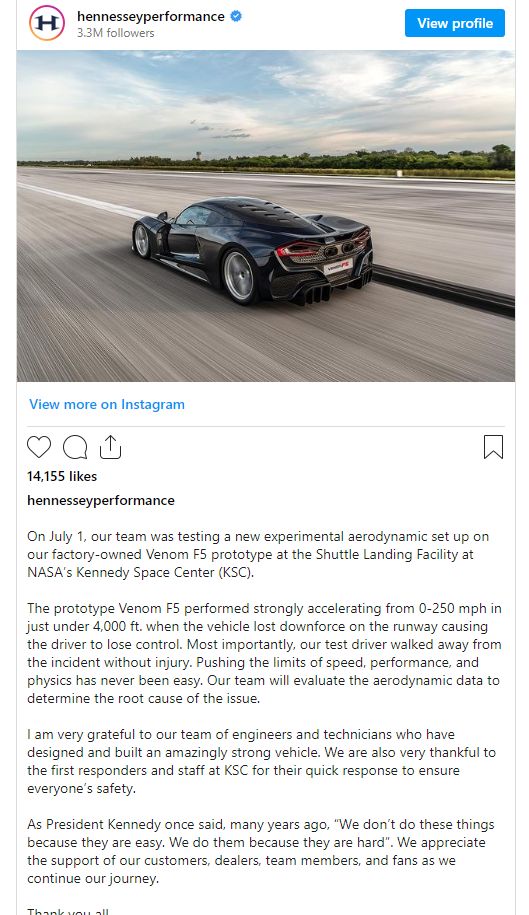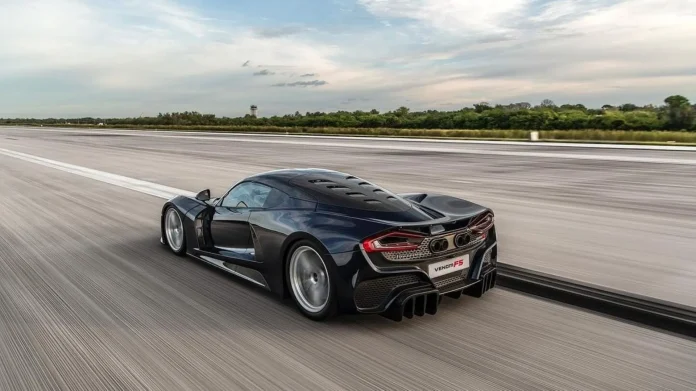Hennessey Venom F5: Faster Than a Florida Man’s Alligator
The legendary Hennessey Venom F5, a car with more horsepower than a fleet of jets, recently took a little detour at the Kennedy Space Center in Florida. And by detour, we mean it went 250 mph, lost downforce, and decided to take a nap in the Florida swamps. Miraculously, the test driver walked away from the crash without even a scratch. If that isn’t a testament to the car’s design, I don’t know what is!
The Need for Speed: Why 250 MPH Wasn’t Enough
You might be wondering, why on Earth would anyone need to go 250 mph? Well, when you’ve got a car that’s advertised as the fastest production vehicle on the planet with a claimed top speed of 311 mph, 250 mph is just the warm-up lap. Hennessey was testing a new aerodynamic setup for the Venom F5, hoping to improve its straight-line speed. Because why not? If you’ve got the need for speed, you might as well go all out.

Florida: The Ultimate Test Track?
Let’s talk about Florida. It’s not just the land of retirees and theme parks. It’s also home to the Kennedy Space Center, where some of the most daring speed tests take place. Imagine zooming down a track where rockets launch. That’s a level of cool only matched by the Venom F5 itself. But Florida’s unpredictable weather and terrain can be as challenging as a gator on the loose.
The Moment of Truth: 250 MPH and Then…Oops
So there they were, the Hennessey team, pushing the Venom F5 to its limits. At 250 mph, everything was going smoothly. But then, the car lost downforce. What does that mean? In simple terms, it’s like a superhero losing their cape mid-flight. The car lost its grip on the road and decided to go off-road. At 250 mph. Let that sink in.
Walking Away Like a Boss
The most incredible part of this high-speed drama? The test driver walked away without a single scratch. That’s right, folks. Not even a bruise. Hennessey’s founder, John Hennessey, couldn’t be more proud. He credited his team for building an insanely strong vehicle and thanked the quick response from the Kennedy Space Center staff.
Analyzing the Crash: Sherlock Holmes, Meet Hennessey Engineers
Now, the Hennessey team is in full detective mode, analyzing data to figure out what exactly caused the car to lose downforce. Was it a freak occurrence, or is there something more sinister at play? Only time (and a lot of data analysis) will tell. In the meantime, they’ve got to rebuild and prep for the next attempt at breaking that elusive 300-mph barrier.
The recent crash of the Hennessey Venom F5 at the Kennedy Space Center underscores the critical role of data analysis in high-speed automotive testing. During the test, the Venom F5 lost downforce at 250 mph, leading to a severe crash. While the driver emerged unscathed, the incident highlighted potential aerodynamic flaws that need addressing.
Key Points of Analysis:
- Aerodynamic Downforce: The primary focus is understanding why the car lost downforce at such high speeds. Engineers will examine data from wind tunnel tests, computational fluid dynamics (CFD) simulations, and real-time telemetry from the crash to identify any anomalies in the vehicle’s aerodynamic profile.
- Structural Integrity: Despite the crash, the car’s ability to protect the driver indicates robust structural design. Engineers will assess the crash data to evaluate the effectiveness of the safety features and identify areas for improvement.
- Telemetry Data: Comprehensive telemetry data, including speed, G-forces, engine performance, and suspension behavior, will be scrutinized to understand the vehicle’s dynamics leading up to the crash.
- Environmental Factors: Conditions at the time of the crash, such as wind speed, temperature, and track surface, will also be analyzed to determine if external factors contributed to the loss of downforce.
- Human Factors: The driver’s inputs and reactions will be reviewed to ensure that human error did not play a significant role.
By meticulously analyzing these data points, Hennessey aims to enhance the Venom F5’s aerodynamic stability, ensuring future tests can safely push the boundaries of speed. This comprehensive analysis is crucial for achieving their goal of breaking the 300-mph barrier and solidifying the Venom F5’s place as the fastest production car in the world.
What’s Next for the Venom F5?
You would think a 250-mph crash would slow things down, but not for Hennessey. They’re already planning the next steps. The car needs some TLC after the crash, but the team is determined. The goal? To prove that the Venom F5 can hit 311 mph and become the undisputed fastest production car in the world.
The Quest for 300 MPH: America’s Supercar Dream
Breaking the 300-mph barrier isn’t just about bragging rights. It’s about pushing the limits of engineering, design, and sheer audacity. Hennessey aims to show that an American car can achieve what’s often considered the Holy Grail of speed. And let’s be honest, who wouldn’t want to see an American supercar zoom past that 300-mph mark?
Why the Venom F5 is a Game Changer
The Venom F5 isn’t just a car; it’s a statement. With its 1,817 horsepower and aerodynamic design, it’s built for speed and stability. It’s the kind of car that makes you feel like a superhero. And let’s not forget the roar of the engine – a sound that could wake the dead and make even the most stoic car enthusiast grin like a kid in a candy store.
How to Survive a 250-MPH Crash: Lessons from the Pros
Surviving a 250-mph crash isn’t just luck. It’s a combination of advanced engineering, top-notch safety features, and a bit of that test driver magic. Hennessey’s team has clearly mastered the art of building a car that can protect its driver even in the most extreme conditions. So, next time you’re driving your car and feeling a bit too safe, just remember – you’re not going 250 mph in a supercar. Probably.
The Future of Speed: What’s on the Horizon?
Hennessey’s journey with the Venom F5 is far from over. With plans to fix the car and hit the track again, the future looks fast and furious. They’re determined to not only hit but exceed the 300-mph mark. And who knows? Maybe the next test run will finally see the Venom F5 claim its crown as the fastest production car in the world.
Why We Love Speed: The Thrill of the Ride
There’s something inherently thrilling about speed. It’s why we watch races, why we dream of fast cars, and why companies like Hennessey push the limits. Speed represents freedom, power, and the ultimate test of man and machine. It’s about seeing what’s possible and then going even further.
Behind the Scenes: The Life of a Test Driver
Ever wondered what it’s like to be a test driver for a supercar company? It’s not all high speeds and glory. It’s a job that requires nerves of steel, a deep understanding of vehicles, and the ability to react in milliseconds. These drivers are the unsung heroes, putting their lives on the line to push the boundaries of what’s possible.
The Hennessey Legacy: From Humble Beginnings to Speed Demons
John Hennessey started his company with a simple goal: to build fast cars. Today, Hennessey Performance is a name synonymous with speed and innovation. From the early days of modifying cars in a small garage to testing supercars at the Kennedy Space Center, the journey has been nothing short of extraordinary.
The Venom F5: More Than Just a Car
At the end of the day, the Venom F5 is more than just a car. It’s a symbol of ambition, innovation, and the relentless pursuit of excellence. It’s a car that defies expectations and pushes the boundaries of what’s possible. And as long as there are speed enthusiasts in the world, the Venom F5 will continue to inspire and awe.
Final Thoughts: The Thrill of the Chase
The recent crash at the Kennedy Space Center is just a bump in the road for Hennessey. With their eyes set firmly on the future, they’re ready to bounce back, rebuild, and race towards their goal. The quest for speed is far from over, and we can’t wait to see what the Hennessey team achieves next.
So, buckle up, gearheads. The world of high-speed supercars is as thrilling as ever, and the Venom F5 is leading the charge. Whether it’s breaking records or bouncing back from crashes, Hennessey is here to stay. And who knows? Maybe the next time we hear about the Venom F5, it’ll be because it’s broken that 300-mph barrier and secured its place in automotive history.
Now, if you’ll excuse us, we’re off to watch some supercar videos and dream of the day we get to ride in one of these beasts. Because let’s be real – who doesn’t love a good speed story?
Read Also


































